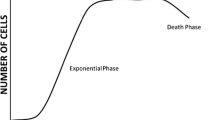Abstract
A recombinant myeloma NS1-derived clone was grown in chemostat cultures in Dulbecco's MEM/Ham's F12 (1∶1) medium containing various concentrations of glucose, at a dilution rate of 0.028 h−1. Serum-supplemented cultures were virtually glucose-limited at a large range of glucose feed concentrations (0.7–5 mM). True glucose-limited cultures, however, were only established at low glucose supply levels to 1.3 mM at a maximum. In cultures obtained at higher glucose concentrations methionine was shown to be the growth-limiting compound. The pattern derived for serum-free chemostat cultures was similar, except that growth yields on glucose were much lower. Glucose was shown to be the growth-limiting substrate in cultures fed with media containing less than 4.5 mM glucose. Upon supplying glucose at higher concentrations such cultures presumably run into methionine and/or tryptophan limitation.
Similar content being viewed by others
Abbreviations
- Ylac,glc :
-
yield of lactate on glucose
- Yx,glc :
-
yield of biomass on glucose
References
Büntemeyer H, Lütkemeyer D and Lehmann J (1991) Optimization of serum-free fermentation processes for antibody production. Cytotechnology 5: 57–68.
Frame KK and Hu W-S (1991) Kinetic study of hybridoma cell growth in continuous culture. I. A model for non-producing cells. Biotechnol. Bioeng. 37:55–64.
Hayter PM, Curling EMA, Baines AJ, Jenkins N, Salmon I, Strange PG, Tong JM and Bull AT (1992) Glucose-limited chemostat culture of Chinese Hamster Ovary cells producing recombinant human interferon-γ. Biotechnol. Bioeng. 39: 327–335.
Kun E and Kearney EB (1974) Ammonia. In: Bergmeyer HU (ed) Methods in enzymatic analysis. Vol. 4, Academic Press, New York, pp. 1802–1806.
Miller WM, Blanch HW and Wilke CR (1988) A kinetic analysis of hybridoma growth and metabolism in batch and continuous suspension culture: effect of nutrient concentration, dilution rate, and pH. Biotechnol. Bioeng. 32: 947–965.
Newland M, Greenfield PF and Reid S (1990) Hybridoma growth limitations: The roles of energy metabolism and ammonia production. Cytotechnology 3: 215–229.
Ray NG, Karkare SB and Runstadler Jr. PW (1989) Cultivation of hybridoma cells in continuous cultures: kinetics of growth and product formation. Biotechnol. Bioeng. 33: 724–730.
Robinson DK and Memmert KW (1991). Kinetics of recombinant immunoglobulin production by mammalian cells in continuous culture. Biotechnol. Bioeng. 38: 972–976.
Seaver SS, Rudolph JL and Gabriels JE (1984) A rapid HPLC technique for monitoring amino acid utilization in cell culture. BioTechniques 2: 254–260.
Shaughnessy TS and Kargi F (1990) Growth and product inhibition kinetics of T-cell hybridomas producing lymphokines in batch and continuous culture. Enzyme Microb. Technol. 12: 669–675.
Author information
Authors and Affiliations
Rights and permissions
About this article
Cite this article
Levering, P.R., van Heijst, J.A.M. & Sünnen, C.M.G. Physiology of myeloma cells grown in glucose-limited chemostat cultures. Cytotechnology 9, 125–130 (1992). https://doi.org/10.1007/BF02521739
Received:
Accepted:
Issue Date:
DOI: https://doi.org/10.1007/BF02521739




